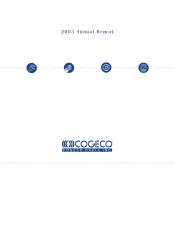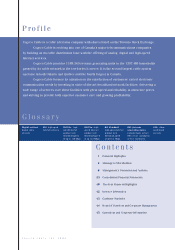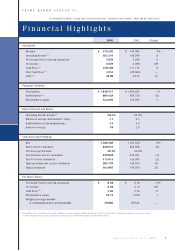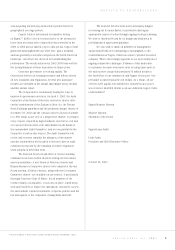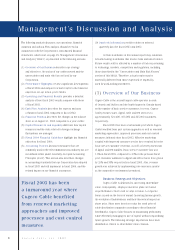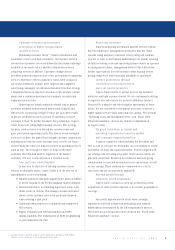Cogeco 2003 Annual Report Download - page 11
Download and view the complete annual report
Please find page 11 of the 2003 Cogeco annual report below. You can navigate through the pages in the report by either clicking on the pages listed below, or by using the keyword search tool below to find specific information within the annual report.
quickly than expected. Third party suppliers have been given
the right to market HSI services offered through the broadband
facilities of cable and telephone networks. Internet access service
providers such as AOL Canada have decided to offer HSI services
in competition with telephone and cable companies. While third
party access or resale has not had a significant impact to date,
there is no assurance that it will not affect the Corporation’s
future growth or market share for HSI services.
The new digital programming services launched in
September 2001 as part of the digital cable service have in most
cases been unable to meet their subscriber penetration, audience
and advertising revenue projections. A few of these upstart
programming services have already ceased operations, and more
may do the same in the near term. Also, it remains unclear
whether the four new French-language digital programming
services licensed in 2000 will meet their final deadline and launch
before September 2004. The lift on digital service revenue
anticipated from the deployment of the VOD platform will depend,
in good measure, on the Corporation’s ability to conclude suitable
VOD exhibition license agreements with program suppliers,
including several major Hollywood movie studios.
The market for video service distribution in Canada
continues to be negatively affected by the theft of satellite signals,
both from unlicensed US direct broadcast satellite (DBS) services
(often referred to as the “black” market) and from licensed
Canadian direct-to-home (DTH) satellite services (often referred
to as the “blue” market). While a combination of public awareness
campaigns, public and private enforcement actions and seizures
have hit some of the key distributors of satellite signal pirating
devices and software in Canada, the technical opportunity and the
economic incentive for widespread theft of satellite signals both
remain unabated. Efforts to repatriate an estimated one million
unauthorised residential users in Canada have not been successful
to date. While the federal government has announced plans to
amend the Radiocommunication Act (Canada) with a view to
providing stiffer penalties and improved means for controlling
the importation and use of pirating devices and software, the
timetable for enactment of the amending legislation and its
coming into force remains uncertain.
Technology
The rate of innovation and improvements in both wireline
and wireless broadband technology remains very quick-paced.
The hybrid fiber-coaxial (HFC) platform used by the Corporation
for its cable systems remains an effective and reliable means
of delivering a wide range of broadband services to the home,
but there is no assurance that the competitive balance between
wireline systems, or between wireline and wireless systems,
will not shift in the future. The open standards and equipment
certification process developed by the North American cable
industry through CableLabs has contributed to the success of
the HFC platform in the era of digital IP-based transmission.
However, Cogeco Cable’s digital services still require the use of
aseparate proprietary technology provided by Motorola that is
not IP-based. Recent breakthroughs in low-cost digital terminals
for video services achieved by Motorola provide an opportunity
to push digital services much more effectively. However, the
full conversion of different local cable systems to complete digital
transmission capability, with the resulting efficiencies in the
use of available bandwidth, still faces unresolved operational,
marketing and regulatory challenges. In the meantime, funds
available for system capacity upgrades required to distribute high-
definition and other additional video services to the same extent as
satellite distributors may be constrained. Work on improvements
to back-up and redundancy capabilities for Cogeco Cable’s plant,
head end and server facilities, particularly in connection with
HSI services, will extend over the next fiscal year.
Regulation
The activities of Cogeco Cable are regulated mainly
under the authority of the Broadcasting Act (Canada) and the
Telecommunications Act (Canada). The CRTC, which is responsible
for exercising regulatory supervision and control under both
statutes, has developed extensive regulatory frameworks for
broadcasting distribution and for telecommunications. Changes in
the rules comprising these respective frameworks, their timing
and their implementation can have a significant impact on the
financial condition, operating results or business of the
Corporation and its subsidiaries.
MANAGEMENT’S DISCUSSION AND ANALYSIS
Nonwithstanding a few exceptions
in remote areas, Cogeco Cable’s
network is now fully digital, with
87% of households passed served
by two-way cable plant.
Cogeco Cable Inc. 2003 9

